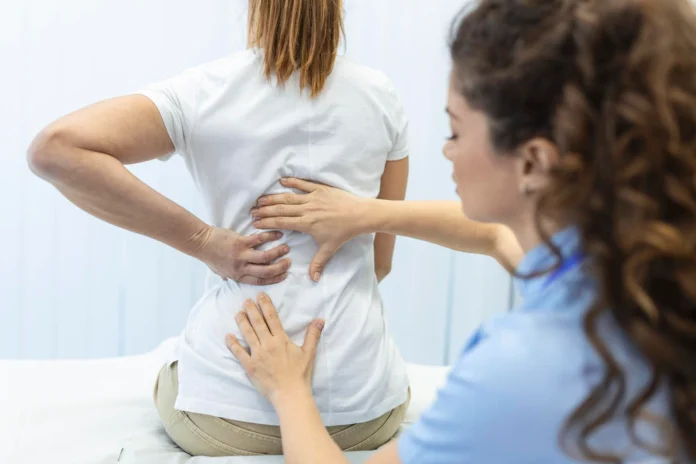
Osteoporosis occurs when your bones become so porous that they collapse and become fragile. It can lead to chronic pain and fractures. Osteoporosis typically develops in older people, but it can happen anytime after age thirty if the bones are weakened by lack of strength or heavyweight, hormonal changes, intense exercise, steroids, or diseases like anorexia or leukemia.
Osteoporosis can lead to several physical disabilities affecting the spine, hips, and upper and lower limbs. The most common symptom is low back pain that persists without apparent reason.
Other problems include:
• Bone fractures of all kinds (due to weak bones).
• Bone deformities.
• Bone spurs.
• Spinal cord compression.
• Chronic pain in the joints.
The more advanced the disease is, the greater the amount of damage that occurs.
Osteoporosis is caused by less dense bones that are weaker and more likely to fracture or break. The foundation for strong bones is laid in your childhood years through adolescence.
Symptoms of osteoporosis

Pain can be the main symptom of osteoporosis. Some people experience back pain or headaches and may experience hunched-over posture because of the loss of bone mass in the vertebrae. Osteoarthritis symptoms include weakness, loss of hip height, a stooped posture, and easily broken bones.
A fracture caused by an osteoporotic bone is most likely to occur at the shoulder where the clavicle is located. In addition to pain and other symptoms related to osteoporosis, people will have a reduced range of motion in their joints due to fragile bones prone to breakage.
Maine Causes Osteoporosis?

1. Hormones
According to data from Medzone, hormone disbalance is the most common reason for osteoporosis. If a woman is subjected to drugs like contraceptive pills (estrogens or progestogens) and Hormonal therapy medicines. These are drugs that are used to treat the symptoms of menopause in women. These hormones can significantly increase the risk of developing osteoporosis.
2. genetic predisposition
Osteoporosis is a prevalent disease. It occurs in 1 out of every five women by age 50. Osteoporosis also occurs in men, but with a much lower incidence, occurring in 1 out of every ten men. The risk of developing osteoporosis increases if both parents have osteoporosis. Other factors involved in the development of osteoporosis are low calcium intake and lack of physical activity.
3. Medical conditions
Some medical conditions can increase the risk of osteoporosis. These include dieting, certain medications, and thyroid disorders. Osteoporosis can be caused by a diet low in calcium and vitamin D, essential for bone health, or a restricted calorie intake. Some women lose their menstrual periods as part of menopause. This loss of the menstrual cycle results in an abnormal loss of calcium. In addition, being overweight or obese is also believed to be linked to osteoporosis development in some women.
4. Bad habits
Some studies show that smoking, as well as heavy alcohol consumption, are linked to osteoporosis. Studies have shown that smokers and heavy drinkers are more likely to experience hip, spine, and forearm fractures than nonsmokers and nonsippers.
5. Diet
Low-fat and low-calcium diets can cause osteoporosis because they reduce the amount of calcium in the body. Calcium is a vitamin, but it belongs to the food groups of fat; do not supplement your diet with calcium without considering that these supplements are expensive. It is also recommended that you eat at least 1 cup of dairy and low-fat products every day. Do not neglect to eat foods rich in vitamin D and phosphorus since both are essential for bone development. Regular exercises like weight lifting or walking keep your bones strong and healthy. Be careful if you have orthopedic problems, as often bad habits accompany them.
New treatment

1. Cryotherapy
Cryotherapy is a new and natural treatment based on cooling injuries or diseased tissue to prevent or treat inflammation and promote the healing process by slowing the activity of damaged tissue. Cryotherapy is based on the biological principle that cells are damaged more quickly when they are hot than when cold. Heating a given area increases capillary circulation, dilation of blood vessels, blood flow, and red blood cell concentration, all accelerating tissue repair. In contrast, cooling causes vasoconstriction, decreases capillary circulation, and slows tissue repair.
2. Hormonal therapy
There are new treatments for the manifestation of osteoporosis. These include hormonal therapy and bisphosphonates; besides, the use of clinical diagnosis of osteoporosis has been improved with the introduction of bone densitometry, which virtually estimates the bone mineral density by x-ray analysis. This technique is considered to be more accurate and reliable than radiography. Bisphosphonates do not treat osteoporosis directly but prevent it from developing.
3 . Nanotechnology
Nanotechnology is considered one of the most revolutionary techniques one can use to treat osteoporosis. Nanotechnology is a field that deals with the manipulation of materials at petite lengths and masses.
Prevention of Osteoporosis

Osteoporosis is preventable by taking calcium supplementation and following a healthy diet. Individuals with high calcium intake tend to have a reduced risk of fractures and osteoporosis. Calcium supplements are very effective in preventing osteoporosis if they are used regularly. To ensure that the person is getting enough calcium in their diet, they should take one or two capsules very often during the day, such as one or two capsules daily between meals.
Osteoporosis is a common disease that can cause severe bone fractures in the elderly. This disease is preventable since it is caused by bad habits and genetics, which are controllable.
It is essential to use bone density screening in individuals at high risk of osteoporosis. In addition to calcium supplements and lifestyle changes, hormone therapy for some individuals can significantly reduce the risk of developing this disease.


